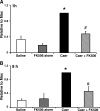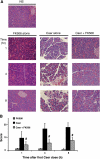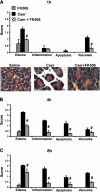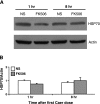Protease activation during in vivo pancreatitis is dependent on calcineurin activation
- PMID: 20501444
- PMCID: PMC2777459
- DOI: 10.1152/ajpgi.00181.2009
Protease activation during in vivo pancreatitis is dependent on calcineurin activation
Abstract
The premature activation of digestive proenzymes, specifically proteases, within the pancreatic acinar cell is an early and critical event during acute pancreatitis. Our previous studies demonstrate that this activation requires a distinct pathological rise in cytosolic Ca(2+). Furthermore, we have shown that a target of aberrant Ca(2+) in acinar cells is the Ca(2+)/calmodulin-dependent phosphatase calcineurin (PP2B). In this study, we hypothesized that PP2B mediates in vivo protease activation and pancreatitis severity. To test this, pancreatitis was induced in mice over 8 h by administering hourly intraperitoneal injections of the cholecystokinin analog caerulein (50 microg/kg). Treatment with the PP2B inhibitor FK506 at 1 and 8 h after pancreatitis induction reduced trypsin activities by greater than 50% (P < 0.005). Serum amylase and IL-6 was reduced by 86 and 84% relative to baseline (P < 0.0005) at 8 h, respectively. Histological severity of pancreatitis, graded on the basis of pancreatic edema, acinar cell vacuolization, inflammation, and apoptosis, was reduced early in the course of pancreatitis. Myeloperoxidase activity from both pancreas and lung was reduced by 93 and 83% relative to baseline, respectively (P < 0.05). These data suggest that PP2B is an important target of the aberrant acinar cell Ca(2+) rise associated with pathological protease activation and pancreatitis.
Figures







References
Publication types
MeSH terms
Substances
Grants and funding
LinkOut - more resources
Full Text Sources
Other Literature Sources
Medical
Research Materials
Miscellaneous

